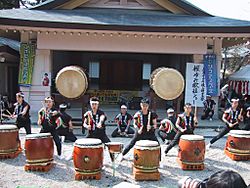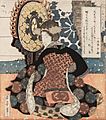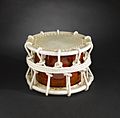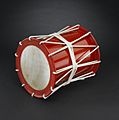Taiko facts for kids

|
|
| Percussion instrument | |
|---|---|
| Other names | wadaiko, taiko drum |
| Classification | Percussion |
| Hornbostel–Sachs classification | 212.2 (Instruments in which the membrane is struck directly, which have tubular bodies.) |
| Inventor(s) | Unknown, origin possibly from India, China, or Korea. |
| Developed | 5th-7th century CE |
Taiko (太鼓) means simply "drum" in Japanese. Outside Japan, the word is used to refer to any of the different kinds of Japanese drums (和太鼓, wadaiko, "Japanese drum" in Japanese) and to the more or less new art of taiko drumming bands (sometimes better called, "kumi-daiko", 組太鼓). The taiko drum originated in the country of Japan. This drum was created by Daihachi Oguchi in 1951. The taiko drum makes a very loud, deep sound.
In a traditional Japanese village the odaiko (big drum) defined the extent of the village land. In modern Japan, wadaiko has become more of a performance art, seen only during festivals or in concert. The most famous Wadaiko performance group are 'Kodo' (meaning heart-beat). They are not only the worlds most respected Japanese drumming group, they also maintain many traditional art forms. They group lives on the island 'Sado Higashima' and live together as a community in a traditional way. Many other cultures have adopted this style of drumming, from Germany and the United States to Australia.
Images for kids
-
Haniwa, dated to the 6th century CE. The left and right depict two drum performers. The statue on the left, depicted using a stick on a barrel-shaped drum, represents the earliest evidence of taiko usage in Japan.
-
Bachi are sticks used specifically for taiko performance, and can be slightly thicker than typical drum sticks.
See also
 In Spanish: Taiko para niños
In Spanish: Taiko para niños



















